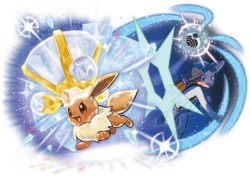Terastal phenomenon
The Terastal phenomenon or Terastallization (Japanese: テラスタル Terastal) is a temporary transformation affecting Pokémon that was introduced in Generation IX. It gives Pokémon a gem-like appearance and changes their type.
Terminology
Some terms related to this game mechanic include:
- Terastal phenomenon or Terastallization (Japanese: テラスタル Terastal) is the transformation.
- Terastallize (Japanese: テラスタルする Terastallize) is the related verb for this transformation.
- Tera Pokémon (Japanese: テラスタルポケモン Terastal Pokémon), also known as Terastallized Pokémon (Japanese: テラスタルしたポケモン Terastallized Pokémon), are Pokémon affected by this transformation.
- The Tera Type (Japanese: テラスタイプ Teras Type) is the type of the Terastallized Pokémon.
- Terastal energy (Japanese: テラスタルエネルギー Terastal energy) is the energy involved in this transformation.
- The Tera Jewel (Japanese: テラスタルジュエル Terastal Jewel) is the jewel on top of the head of a Terastallized Pokémon.
- The Tera Orb (Japanese: テラスタルオーブ Terastal Orb) is the Key Item that allows a Pokémon to Terastallize.
- Tera Shards (Japanese: テラピース Tera Piece) are any of the items that change a Pokémon's Tera Type. There are 19 Tera Shards, one for each type, including Stellar.
- A Tera Raid Battle (Japanese: テラレイドバトル Tera Raid Battle) is a type of Pokémon battle.
- Tera Blast (Japanese: テラバースト Tera Burst) is a damage-dealing move related to this phenomenon.
- Terastallized state (Japanese: テラスタルした姿 Terastal Appearance) refers to the appearance and effects that certain Pokémon exhibit when they undergo the process of Terastallization.
- Terastal Form is a form of Terapagos, automatically assumed in battle through its Tera Shift ability.
- Tera Starstorm (Japanese: テラクラスター Tera Cluster) is a damage-dealing move also related to this phenomenon.
Some examples of in-game dialogue from Pokémon Scarlet and Violet:
- "When it is charged with energy, it can be used to cause Pokémon to Terastallize." (excerpt from the description of Tera Orb)
- "If the user has Terastallized, it unleashes energy of its Tera Type." (excerpt from the description of Tera Blast)
- "If an opponent’s Pokémon Terastallizes during battle... observe a Pokémon's Tera Jewel closely to see which type it has become!" (Hassel)
- "Terastallizing gives a real boost, see!" (Nemona)
In the core series games
History
There is a lot of mystery surrounding the Terastal phenomenon and why it only happens in Paldea. Professor SadaS/Professor TuroV was known to be researching this mysterious transformation.[1] It is later revealed that the Terastal phenomenon also occurs in Kitakami.
The Terastal phenomenon was first discovered 140 years ago in Area Zero along with Terastallized Pokémon at the bottom of the Great Crater of Paldea. However, attempts to remove Terastallized Pokémon from the crater caused the light to disappear. Further details of the Terastal phenomenon thus remained unclear for a while.
Ten years before the events of Pokémon Scarlet and Violet, the game's professor began investigating the phenomenon, and discovered that the energy emitted from shining crystals in Area Zero is what triggers it. The Tera Orbs were then created by the professor from the Terastal energy located in Area Zero, with support from Director Clavell. This allowed people to Terastallize their Pokémon outside of Area Zero. The Tera Orb was then shared to the Paldea League and Naranja AcademyS/Uva AcademyV.
At some point, the Terastal energy was used by the professor to create a time machine, bringing in Paradox Pokémon from the ancient pastS/distant futureV, including a pair of KoraidonS/MiraidonV.
The crystalline petals of Glimmora seem to resemble the Tera Jewels that appear during the Terastal phenomenon. It is unknown if there is a connection between Glimmora and the Terastal phenomenon, though many of them (along with its pre-evolution, Glimmet) can be found in Area Zero, the place where the phenomenon originated. Additionally, eight Glimmet Crystals are needed to make TM171 (Tera Blast), a move that changes type upon Terastallizing.
The Scarlet Book/Violet Book makes cryptic hints that it may be linked to an unknown Pokémon resembling a disk made of layers of overlapping hexagons, but the truth of this has yet to be confirmed. A journal in Research Station No. 1 further implies its existence and relationship to the phenomenon. The journal reads:
"We've determined that this energy crystallization is linked to the being we call ▊▊▊▊▊▊. The interlocking hexagonal plates that comprise ▊▊▊▊▊▊'s shell must somehow cause this phenomenon—which I've dubbed 'Terastallizing.'"
This Pokémon is ultimately confirmed to be Terapagos. A nineteenth Tera Type, the Stellar type, was later discovered and named by Professor SadaS/Professor TuroV.[2]
| Spoilers end here. |
|---|
Effects

Trainers who obtain a Tera Orb are able to use it to Terastallize their Pokémon, which makes a Tera Jewel appear above the Pokémon's head and causes the Pokémon's body to glisten like polished, faceted gemstones. This changes the Pokémon's defensive type(s) to its Tera Type, removing all other types. Terastallized Pokémon are identified by having "Tera" in front of their name.
While Terastallized, Pokémon receive STAB on moves matching their Tera Type, in addition to moves matching the types they had immediately before Terastallizing. If the Pokémon's Tera Type is the same as one of its original types, moves of that type receive a ×2 power boost instead of the usual ×1.5.[1]
During this time, Adaptability works only for the Tera Type (with ×1.5 becoming ×2, and ×2 becoming ×2.25). Additionally, moves of the Tera Type that have base power below 60 but are not a multi-strike move or an increased priority move are stealthily boosted to 60BP; this is checked for after Technician's boost.[3] Pokémon can only have one Tera Type. The move Tera Blast changes type to the Pokémon's innate Tera Type upon Terastallizing.[4]
Terastallized Pokémon cannot have their type changed from moves and Abilities such as Soak, Double Shock, Protean, or Transform. A Pokémon using Transform before Terastallizing will not copy its opponent's Tera Type and will instead keep its own.
The Terastal phenomenon lasts until the battle ends or the Terastallized Pokémon faints. After being used once, the Tera Orb loses all its Terastal energy and has to be recharged by either touching crystals containing Terastal energy or by visiting a Pokémon Center.[1] An exception to this can be found in Area Zero, where the Tera Orb will automatically recharge at the end of each battle after it is used. Upon capturing Terapagos at the end of The Indigo Disk, the Tera Orb will be infused with Terapagos' energy and will no longer require charging.
After beating the Medali Gym, the player can change their Pokémon's Tera Type at the Treasure Eatery by exchanging 50 Tera Shards of a given type with the chef.
The Terastal phenomenon is only found in Paldea, apparently due to the Terastal energy seeping from the ground of the region,[1] as well as Kitakami. It is also usable in the Blueberry Academy due to Briar's research.
Catching Tera Pokémon
Normal wild Pokémon found in Paldea typically have a Tera Type that matches one of their normal types. This Tera Type does not reflect their potential evolutions and cannot be passed down through breeding. For example, a Charcadet will always have a Fire Tera Type. Typically, there are only two ways to obtain a wild Tera Pokémon with unique typing: either catch a wild Tera Pokémon scattered around Paldea, or participate in a Tera Raid Battle. These Pokémon may know TM moves that match this set Tera Type.
Wild Tera Pokémon
There are 68 wild Tera Pokémon scattered around Paldea, the majority with unique Tera Types. They can be found in fixed locations and typically have Tera Types different from their base types, a notable exception being the eight Eeveelutions, who have Tera Types that match their base types, and would normally have a Normal Tera Type if evolved from Eevee. The wild Tera Pokémon are indicated by a bright glow emitting from their bodies, and when battled against will immediately Terastallize. Wild Tera Pokémon cannot be caught while Terastallized until after they lose their Tera Jewel, which will happen after sustaining a certain amount of damage from direct attacks. Once this threshold is reached, the damage the Pokémon has taken will be capped until they lose their Tera Jewel, even from multi-strike moves.
Wild Tera Pokémon will eventually respawn after being caught or defeated and will always have a perfect 31 in at least three of their IVs.
Tera Raid Battle
Tera Raid Battles occur all over Paldea, with the locations changing at random each real-life day at midnight. These locations are indicated on the map, and in the overworld are indicated by a large, colored "shining crystal", with a beam of sparkling lights shooting into the sky.
Tera Jewels
| Type | Image | Description |
|---|---|---|
| Normal | 
|
The Normal-type Tera Jewel is based on a diamond ring, or possibly a Normal Gem. |
| Fighting | 
|
The Fighting-type Tera Jewel is based on a large fist rising upwards in an uppercut motion, similar to All-Out Pummeling and Max Knuckle. |
| Flying | 
|
The Flying-type Tera Jewel is based on a cluster of helium balloons, a possible reference to Flying Pikachu. Some of the official art for the phenomenon features Pikachu, and a Flying Tera Type Pikachu has been distributed as a Mystery Gift. |
| Poison | 
|
The Poison-type Tera Jewel is based on the skull and crossbones, the standard warning sign for poisonous substances, which has also been used for the Generation I animation for receiving Poison damage. |
| Ground | 
|
The Ground-type Tera Jewel is based on a cut-through model of the Earth. |
| Rock | 
|
The Rock-type Tera Jewel is based on the Parthenon, an ancient temple being part of the Acropolis of Athens. |
| Bug | 
|
The Bug-type Tera Jewel is based on the wings and antennae of an insect. |
| Ghost | 
|
The Ghost-type Tera Jewel is based on the Generation I sprite of a ghost. |
| Steel |  
|
The Steel-type Tera Jewel is based on a single-bladed axe. |
| Fire | 
|
The Fire-type Tera Jewel is based on a candelabra or chandelier. |
| Water | 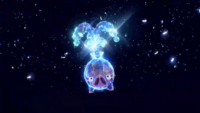
|
The Water-type Tera Jewel is based on a water fountain. |
| Grass | 
|
The Grass-type Tera Jewel is based on a bouquet of flowers. |
| Electric | 
|
The Electric-type Tera Jewel is based on a lightbulb. |
| Psychic | 
|
The Psychic-type Tera Jewel is based on an eye, resembling the type's TCG type symbol. |
| Ice | 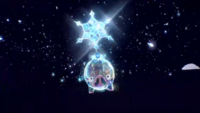
|
The Ice-type Tera Jewel is based on a snowflake. |
| Dragon | 
|
The Dragon-type Tera Jewel is based on the head and wings of a dragon. |
| Dark | 
|
The Dark-type Tera Jewel is based on a face with a mischievous grin. |
| Fairy | 
|
The Fairy-type Tera Jewel is based on a winged heart. |
| Stellar | 
|
The Stellar-type Tera Jewel is based on a large crown orbited by the eighteen type symbols, crowned with a gem shaped like the Normal Form of Terapagos and the Terastallization symbol floating above it. |
Special Terastallized state
Some Pokémon species have a special Terastallized state, which changes their appearance significantly when Terastallizing, instead of simply gaining their Tera Type's jewel.
Currently, Ogerpon and Terapagos are the only Pokémon known to have special Terastallized states, as well as the only ones which cannot otherwise change their Tera Types. This also makes Ogerpon the only Pokémon incapable of being Stellar type.
| Ndex | Pokémon | Type | Terastallized state | |
|---|---|---|---|---|
| #1017 | 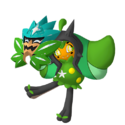
|
Ogerpon Teal Mask |
Grass | File:Teal Mask Ogerpon's Terastal form.png |

|
Ogerpon Wellspring Mask |
Water | File:Wellspring Mask Ogerpon's Terastal form.png | |
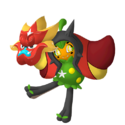
|
Ogerpon Hearthflame Mask |
Fire | File:Hearthflame Mask Ogerpon's Terastal form.png | |

|
Ogerpon Cornerstone Mask |
Rock | File:Cornerstone Mask Ogerpon's Terastal form.png | |
| #1024 | 
|
Terapagos Terastal Form |
Stellar | 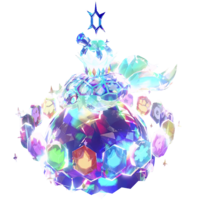
|
In the spin-off games
Pokémon Mezastar
In the anime
Main series
Pokémon Horizons: The Series

The Terastal phenomenon debuted in HZ010, where Brassius Terastallized his Sudowoodo into a Grass type during his battle with Roy. After the battle, Nemona explained how the phenomenon works to Liko and Roy. Unlike in the games, Terastallization is possible in regions not related to Paldea, as shown in HZ025.
In HZ014, Friede Terastallized his Charizard into a Dark type for the first time during his fight against Spinel's Magneton and Beheeyem.
Gallery
Pokémon: Paldean Winds
In Breathe In, during a rematch between Aliquis and Nemona, both Trainers Terastallized their Pokémon, a Combat Breed Paldean Tauros and Meowscarada, respectively.
In Breathe Together, a Trainer's Terastallized Pawmot is seen battling against Aliquis's Terastallized Meowscarada.
Gallery
Biri-Biri
In the animated video for the song Biri-Biri, a Terastallized Glimmora briefly appeared. Later, both Anna and Nemona were seen Terastallizing their Pokémon, a Skeledirge and Meowscarada, respectively.
Gallery
In the manga
Pokémon Adventures
Scarlet & Violet arc
Terastallization debuted in PASV01, where Nemona Terastallized her Pawmi into an Electric type.
In the TCG
- Main article: Pokémon ex (TCG)

Terastallized Pokémon were first introduced in the English Scarlet & Violet expansion (the Japanese Scarlet ex and Violet ex expansions) as Pokémon ex cards. These Pokémon are known as Tera (Japanese: テラスタル Terastal) Pokémon. While on the Bench, Tera Pokémon do not receive any damage from attacks done by either player.
Some Tera Pokémon ex can have types that differ from their usual types. These so-called type-shifted Tera Pokémon ex use the same Energy as their usual type for attacks; however, they have a different Weakness that corresponds with their shifted type.
Trivia
- If the player chooses Fuecoco, no NPC Trainer in Pokémon Scarlet and Violet Terastallizes their Pokémon into the Fire type, not counting The Indigo Disk, where Crispin Terastallizes his Blaziken into the Fire type.
In other languages
| ||||||||||||||||||||||||||
Tera Type
| ||||||||||||||||||||||||||
References
- ↑ 1.0 1.1 1.2 1.3 (August 3, 2022). "Pokémon Shine and Glimmer Like Gems Thanks to the Terastal Phenomenon." Pokémon Scarlet and Pokémon Violet Official Website
- ↑ https://scarletviolet.pokemon.com/en-us/news/new_tera_type/
- ↑ https://twitter.com/skittyve/status/1599911349764571137
- ↑ (August 21, 2022). "Master Using the Terastal Phenomenon in Battle!" Pokémon Scarlet and Pokémon Violet Official Website
See also
- Z-Move
- Myths and legends involving Legendary and Mythical Pokémon
- Koraidon
- Miraidon
- Area Zero
- Area Zero journals
- Tera Raid Battle
- δ Delta Species (TCG)
- The Hidden Treasure of Area Zero

|
This game mechanic article is part of Project Games, a Bulbapedia project that aims to write comprehensive articles on the Pokémon games. |
